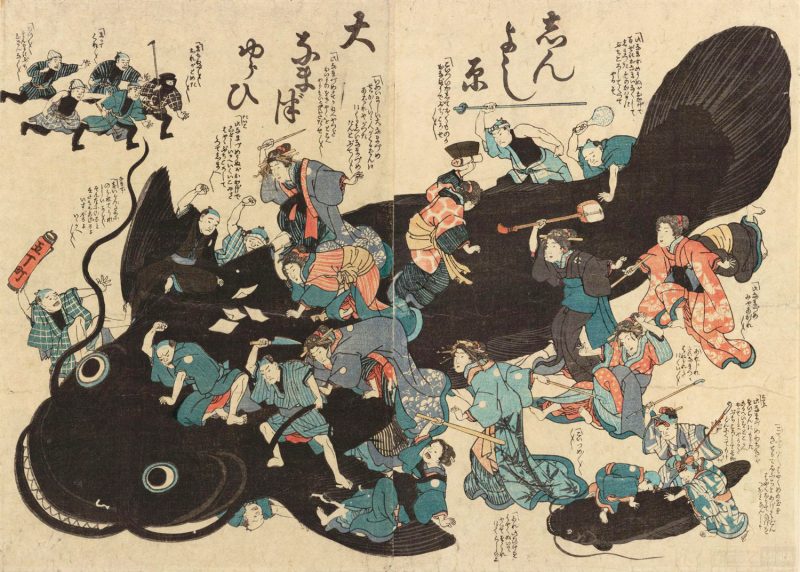The Worm, the Catfish, and the Quakes
Posted on October 26, 2018In Praise of Myth in Disorientation of Knowledge
“Who is Worm?” he asked with some hesitation.
“Worm lives underground. He is a gigantic worm. When he gets angry, he causes earthquakes,” Frog said. “And right now he is very, very angry.”
“What is he angry about?? Katagiri asked.
“I have no idea,” Frog said.
“Nobody knows what Worm is thinking inside that murky head of his. Few have ever seen him. He is usually asleep[…] If you ask me, I’d guess he probably isn’t thinking anything at all, just lying there and feeling every little rumble and reverberation that comes his way, absorbing them into his body, and storing them up. And then, through some sort of chemical process, he replaces most of them with rage. Why this happens I have no idea. I could never explain it.”1
Every time an event of critical magnitude strikes, an event of the known and unknown thrashes upon the realm; every time the crusts, in- and out-side, crack and wound to bleed; every time spheres twist and turn and dislocate from their arbitrary axises; everytime time tangles into pre-time and post-time, earth beings are violently made aware of the spinning chaos and irrepressible entropy of the cosmic reality. The reactions to human actions and inactions are directed in multiple directions and multiple planes, striking the counted and uncounted, the seen and unseen, the center and the peripheral in a distorted gradient of pain and ecstasy. Were there any reasons in shuffling and shaking time and space, human asks, to which only silence laughs at the bruised beings. Shaken out of their immunological spheres2, humans are reminded, time and time again, that they are not the master of the game, that there are secrets of the old ones, the chthonic ones3, outside of the self-elected insular containers that the immature species have yet to grasp and horrendously force causes and reasons upon.
I could never explain it.
In 1855, following an earthquake with a magnitude of approximately 7.0 in Edo, now known as Tokyo, prints of nazamu, or catfish, showed up in the market with great quantity and variety, unintentionally became a social phenomenon4. The myth had it that namazu lives under the islands of Japan and would thrash about and cause large earthquakes whenever its guard, the Thunder god Kashima let his guard down5. In these prints, Namazu switched itself eloquently from a big black mass with big eyes and long whiskers to an anthropomorphic form, wearing human clothes and engaging in human-like activities. The depicted humans would revere, struggle, win, lose, and on some occasions, slit a sword over the namazu head; as their bodies in the physical realm reconciled with pain, making peace with loss, seeing the madness in its eyes, and burying time in agony.

Shin Yoshiwara ōnamazu Yurai or ‘The Cause of the Great Catfish at Shin Yoshiwara’, (1855), artist unknown. Source: 广而告之-让您家喻户晓
Set in a turbulent backdrop of the declined Edo era and the bafuku government, the Ansei Great Earthquake was considered an act of yonaoshi, or world rectification, a manifestation of cosmic displeasure against the misalignment of values engraved in the fabric of the cosmo6. The prints served as a medium to seed and recenter the myth in communal awareness, a deliberate effort of translation and apprehension of Heaven messages, a sign of warning and calling coming from within. In a disoriented space, this act of fabulation diverted the dormant stream of reasoning, a medium in which one is free to subject one’s insular psyche to the consequences of the contemporary, man-made scandals7. Due to the potent damages caused and yet to cause but seemingly and definitely will cause, the prints were suspended within only two months by the military government; yet the fable survives, morphs, regenerates and transforms like a living being of a wider, more compassionate, more knowing cosmic dimension.
Yet myths, at the force of the modern sterilization of languages, thoughts, and reasonings, of the tyrannical and heedless vector of progress, are plucked, sterilized, persecuted and buried. Modern myths, in carefully-crafted contemporary forms of religious and cultural production, are genetically modified to shape, coerce, and deceive the Other into oppression8.
Where are we when we are in the monstrous?9
In locating the responsibility of design in this transition of time and space, perhaps it is critical to relocate and excavate the buried myths; to make quakes of the psyche; to disturb the structure of forms and languages, of thoughts and reasonings; to contaminate the sources and queer10 the castle of orthodoxy; to listen and conjure the ghosts of other beings. Perhaps it is a horizontal movement, a labor of love for the sites of collapsed and deconstructed, the failure of sympathy, the death of overindulgence, the sentences with too many commas but never a full stop. Perhaps, design, a myth itself, should reorient to tell and retell stories of the Other.
Nam P.
(1) Super-frog Saves Tokyo, After the Quake, Haruki Murakami (2000)
(2) Sloterdijk, Peter. Bubbles: Spheres Volume I: Microspherology. Semiotext(e) (October 14, 2011). 630
(3) Donna Haraway, Staying with the Trouble: Making Kin in the Chthulucene, 2016
(4) Shaking Up Japan: Edo Society And The 1855 Catfish Picture Prints, Smits, Gregory, Journal of Social History; Summer 2006; 39
(5) Kennedy, Philip, and Philip Kennedy. 2016. “When Giant Catfish Shook The Earth: The Namazu-E Prints – Illustration Chronicles”. Illustrationchronicles.Com. Accessed October 21 2018. https://illustrationchronicles.com/When-Giant-Catfish-Shook-The-Earth-The-Namazu-e-Prints
(6) Smits, 2006
(7) Donna Haraway, 2016
(8) Can the subaltern speak?, Gayatri Chakravorty Spivak, 1988
(9) Sloterdijk, 1998
(10) Merritt Kopas, Naomi Clark, QCCON 2014